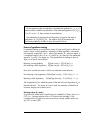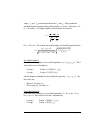
Page 18-41
The criteria to use for hypothesis testing is:
Θ Reject H
o
if P-value < α
Θ Do not reject H
o
if P-value > α.
Paired sample tests
When we deal with two samples of size n with paired data points, instead of
testing the null hypothesis, H
o
: μ
1
-μ
2
= δ, using the mean values and standard
deviations of the two samples, we need to treat the problem as a single sample
of the differences of the paired values. In other words, generate a new random
variable X = X
1
-X
2
, and test H
o
: μ = δ, where μ represents the mean of the
population for X. Therefore, you will need to obtain⎯x and s for the sample of
values of x. The test should then proceed as a one-sample test using the
methods described earlier.
Inferences concerning one proportion
Suppose that we want to test the null hypothesis, H
0
:p = p
0
, where p represents
the probability of obtaining a successful outcome in any given repetition of a
Bernoulli trial. To test the hypothesis, we perform n repetitions of the
experiment, and find that k successful outcomes are recorded. Thus, an
estimate of p is given by p’ = k/n.
The variance for the sample will be estimated as s
p
2
= p’(1-p’)/n = k⋅(n-k)/n
3
.
Assume that the Z score, Z = (p-p
0
)/s
p
, follows the standard normal distribution,
i.e., Z ~ N(0,1). The particular value of the statistic to test is z
0
= (p’-p
0
)/s
p
.
Instead of using the P-value as a criterion to accept or not accept the hypothesis,
we will use the comparison between the critical value of z0 and the value of z
corresponding to α or α/2.
Two-tailed test
If using a two-tailed test we will find the value of z
α/2
, from
Pr[Z> z
α/2
] = 1-Φ(z
α/2
) = α/2, or Φ(z
α/2
) = 1- α/2,


















